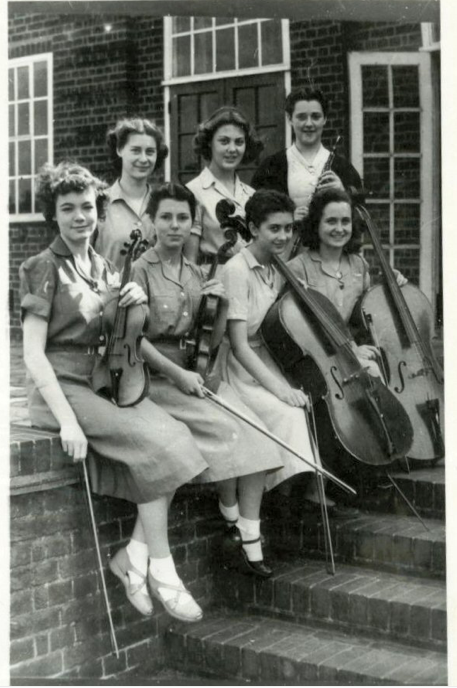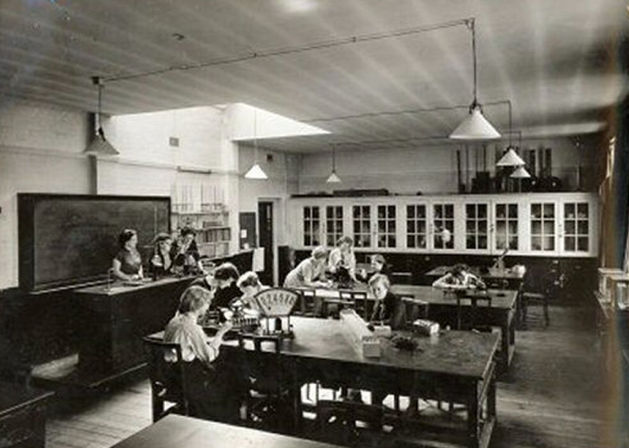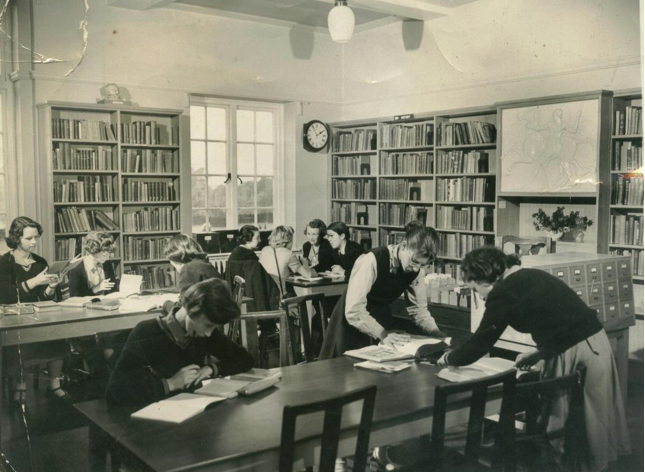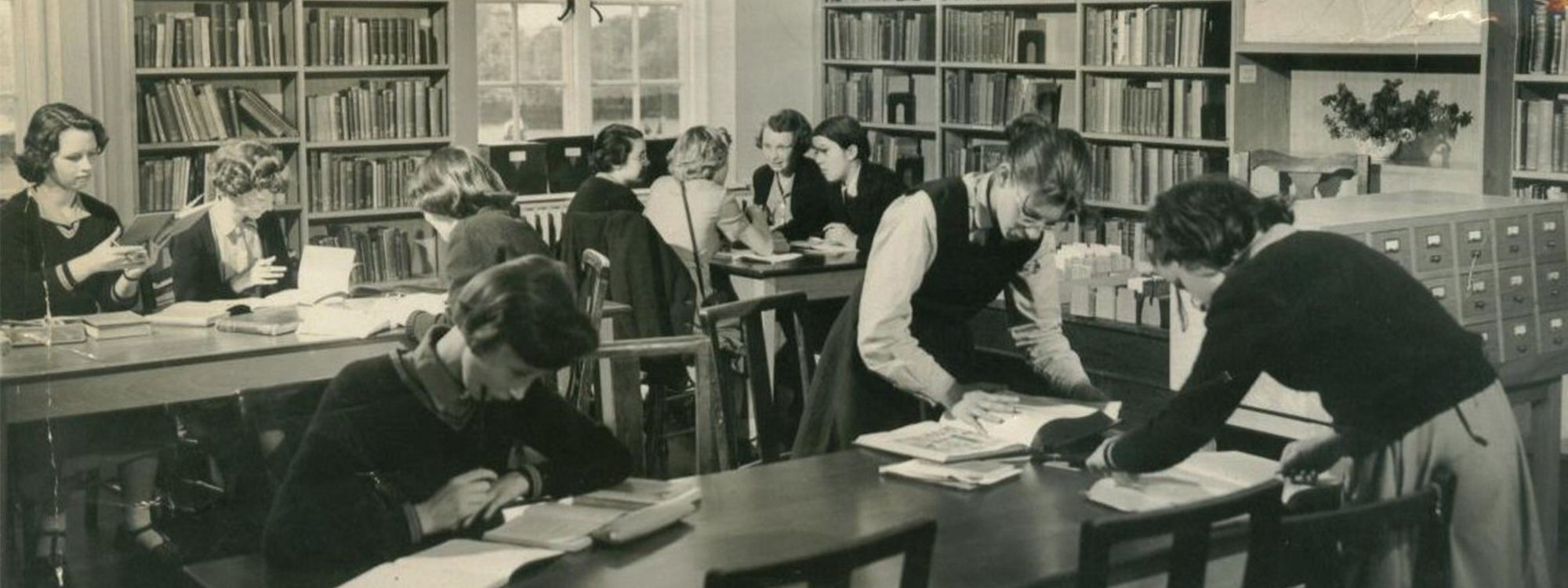1945 - 1972
Finally however the war in Europe ended, the Rest Centre closed and the school began to fill up again. Evacuated families returned to London and new pupils joined the school in all years, though it was not until September 1946 that the school was full again. At the Speech day in 1946, the Headmaster of Abertillery County School unveiled a plaque to commemorate the evacuation and the kindness and hospitality the school had received from their Welsh hosts.
The first post-war year had its difficulties. Labour could not be spared to clear and restore the playing field, new library books were almost unobtainable and new school furniture non-existent. Examinations were undisturbed by air-raids, girls were no longer liable for ‘call-up’ to military service but 90% of university and medical school places were reserved for ex-Service applicants and not available to those leaving school. Despite this, this several girls obtained places at university and college.
From 1947 onwards, school life settled back into the regular routine of academic work, sport, music and clubs, which had been a familiar part of pre-war days. There followed several uneventful years, troubled only by shortages of supplies resulting from the national economic situation. The only slight cloud on the horizon was the knowledge that the L.C.C. was planning, over the following few years, to build two large new schools in Eltham. These would be mixed and comprehensive, taking children from all ranges of ability. In September 1951 Miss Ozanne spoke of the possibility that Eltham Hill might be incorporated into one of these schools at a later date, but she pointed out “this can scarcely be in the school life of even the youngest of present pupils”.

Music Group – 1950
Within a year all this was changed when in 1952 the L.C.C. announced that Eltham Hill was to close and the pupils be transferred to form the nucleus of the new school being built at Kidbrooke. This decision caused surprise and consternation to most staff and parents. Staff were not allowed to make public comment but an active campaign, bled by a group of parents, was fought, increasingly bitterly, to prevent the closure. The group organized an appeal to the Minister of Education that was ultimately successful. On the 2nd March 1954, Dame Florence Horsbrugh, Minister of Education, announced that after consideration “of the reputation of the school and the success with which it had served its purpose as a grammar school” the closure would not be permitted.
Eltham Hill had now to recover from the setbacks of this uncertainty. This was made a harder task by the retirement of Miss Ozanne at the end of 1952. She had been appointed in 1931 to the difficult role of following the legendary Miss Bramwell and cannot have begun to imagine the events, which were to shape her time as headmistress. Throughout the 1930’s she had guided the school into the pre-eminent position it occupied in 1939, only to see her achievements undermined by war and evacuation. She took in her stride billeting problems, homesickness, classes in hotel dining rooms, church halls and even the beach, and the hurried flight to Wales in 1940. Throughout that time she gave the stability to staff and pupils that enabled them to make the successful return to the old standards and traditions.

Physics laboratory – 1955
To follow Miss Ozanne, the Governors appointed Miss Nancy Clark. She had been on the staff of the school since 1939, accompanying them to Folkestone and Abertillery, and supervising the re-opening of the school in Eltham. To Miss Clark fell the task of restoring confidence in Eltham Hill after the divisions and disharmony of the closure attempt. She was able to do this so successfully that the Golden Jubilee celebrations were held in 1956, culminating in a service of thanksgiving in Southwark Cathedral. A review in 1956 of the achievements of old girls included a one-time government minister, missionaries, doctors, teachers, nurses, librarians and those working in social work, art, music and public service.

Library – 1956
After the Golden Jubilee celebrations, the school settled to a period of steady work and growth in numbers, especially in the Sixth Form. By the end of the fifties, there were 540 pupils and among former pupils the first Oxford “First” and the first dentist had been celebrated. In 1960 the school harnessed its energies to massive efforts for World Refugee Year, culminating in a huge, daylong fete. The enormous sum of £1000 was raised, the equivalent of at least $10000 in 1996 terms. In 1960 also, Miss Clark retired and Miss E. Timberlake was appointed as headmistress. Miss Clark had returned the school to stability after the uncertainties of the first attempt at change in 1952, but change was becoming inevitable. The building was too small for its numbers and the specialist rooms were inadequate. In the education world outside, the movement in favour of comprehensive education was gaining ground rapidly, especially in the L.C.C. and its successor body the Inner London Education Authority. Proposals for changing Eltham Hill from a grammar school to a comprehensive were discussed intensively both by staff and governors during the early 1960’s. Most proposals centred around a merger with another school. Any reorganization was of course a political matter, outside the control of individual schools, and no school could successfully fight off such political pressure. Eltham Hill therefore decided to make its own proposal. A plan was put forward for a comprehensive school of about 1000 girls on the existing site; in 1966 this won the backing of the I.L.E.A. Chief Education Officer. However, a change of political power in London shelved the plan and it was not revived until the early 1970’s.

Retirement of Miss Kennedy and Miss Turner – 1965

Miss Timberlake and the Sixth Form – 1964
Meanwhile the lack of accommodation was becoming a serious problem. Plans had been drawn up in 1963 for an additional block to provide extra classrooms, and alterations in the main building to provide extra laboratories, an enlarged library and second staff room.
Work on this building began in 1967 and caused two years of considerable disruption, with delays caused by labour and financial problems. Public examinations were held in church halls and for a time all first year pupils were housed on a different site. Throughout this period the work of the school flourished. In 1960 fewer than twenty pupils were entered for ‘A’ levels – by 1970 that number had grown to 70 and the Sixth Form numbered over 100. New subjects and courses were introduced and the whole curriculum expanded and modernized. The first Careers Convention was held in 1962. There were school drama festivals, productions with local boys’ schools and an increase in music tuition. Experienced players performed with the London Schools’ Symphony Orchestra and the London Schools Band and the school’s own three choirs performed in concerts and operas. The tradition of social service continued and the school sponsored the education of a child in Lesotho for five years through Save The Children Fund. At the same time, the more permissive atmosphere in society in the 1960’s brought about a relaxation in the formal structures of school life. Streaming disappeared completely, formal Prize giving ceremonies were scaled down, Sixth Formers were allowed to give up school uniform and the ‘prefect’ system was abandoned. Ironically it was re-introduced seven years later at the express request of the Sixth Form.

